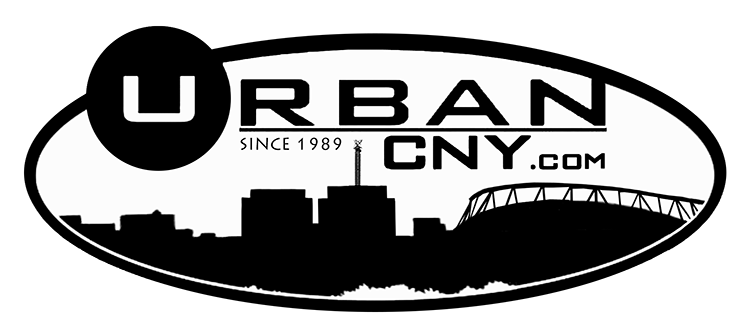Did Government Subsidies Kill a neighborhood Institution?
Wakefern Food Corporation Paid half of the 5 Million Dollar Total Project Cost
The opening of the 35,000 square foot Price Rite Supermarket, located at 611 South Avenue, fulfilled a mission that many residents had embraced and supported for over a decade. History shows that the South Avenue corridor, like every other Syracuse residential neighborhood, was once home to a robust commercial district. Several large grocery stores and other retail operations were located on South Ave., making it markedly similar to James Street in Eastwood, and the city’s eastside business district on Westcott Street. What do these areas have in common? They are examples of Syracuse residential neighborhoods with robust retail activity at their cores; a key element to urban living.
However, over the last 40 years, the implosion of the Syracuse area economy, the South Avenue corridor business district, residential housing, and the overall neighborhood condition went into a tailspin, taking almost everything with it. What remained was block after block of blighted homes, corner stores and vacant lots. At its center remained Southwest Community Center and the few remaining retail operations on South Ave. Over the years, there were signs of life, a Rite Aid pharmacy opened at the corridor’s entry at West Onondaga Street. Longtime residents can recall living in what resembled an urban wasteland that was also classified as a food desert.

A rare opportunity presented itself when Onondaga County was forced to address the raw sewage that often overflowed into Onondaga Creek. The Southwest neighborhood contained one of several sites that had been slated to have a sewage treatment facility installed. To compensate the neighborhood for having a sewage treatment facility installed in its midst, the area was designated to receive a lump sum of money. The funds were to be utilized to make improvements that would be beneficial to homeowners and the community at-large. The discussions took place over an extended period of time. Neighborhood based community groups in the immediate area were also supportive of bringing in a store. The hope was to provide a southern anchor to a neighborhood that had spent the last 25 years transforming from a cluster of empty city blocks into a functioning neighborhood.
Resident-based community forums and focus groups convened to learn the desires of the neighborhood. As ideas were discussed and discarded, the need for a full-service grocery retailer was revealed as something that would benefit the area in the most impactful and meaningful way. The residents worked to articulate the need for a grocery store as there was little hope that there would be another opportunity to invest in something so fundamental to enable the community to thrive. The City of Syracuse commissioned a report to study the feasibility of the area and to ensure that it would be able to support a supermarket.
 Armed with the knowledge that the Southwest community wanted a grocery store, Walt Dixie, the Executive Director of Jubilee Homes of Syracuse, Inc. surveyed the area in 2006. The nonprofit agency had recently completed the construction of 95 homes in the neighborhood. Many of the decrepit rental homes that had once lined Tallman Avenue, South Avenue, Rich, and White Streets had been replaced by modern construction, ushering in a new crop of vested homeowners. The remaining structures on South Avenue were ghosts of the corridor’s retail past. Jubilee Homes assembled a team consisting of staff, community stakeholders and people with specific skill sets for assembling an economic development project. The agency communicated regularly with city, county and state departments and representatives to ensure that no steps were bypassed in the process.
Armed with the knowledge that the Southwest community wanted a grocery store, Walt Dixie, the Executive Director of Jubilee Homes of Syracuse, Inc. surveyed the area in 2006. The nonprofit agency had recently completed the construction of 95 homes in the neighborhood. Many of the decrepit rental homes that had once lined Tallman Avenue, South Avenue, Rich, and White Streets had been replaced by modern construction, ushering in a new crop of vested homeowners. The remaining structures on South Avenue were ghosts of the corridor’s retail past. Jubilee Homes assembled a team consisting of staff, community stakeholders and people with specific skill sets for assembling an economic development project. The agency communicated regularly with city, county and state departments and representatives to ensure that no steps were bypassed in the process.
It would take nearly a decade to develop the Old Loblaw’s Supermarket site at 611 South Avenue and return the structure to its original use as a neighborhood retailer of groceries.
The Emergence of Price Rite
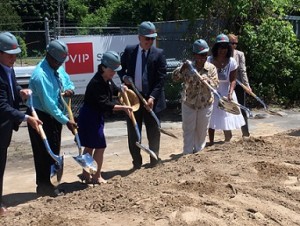
The original idea for a South Avenue market was to attract a locally-owned company to the site. After connecting with a few Syracuse-based grocers and receiving no interest, the supermarket team was forced to cast a wider net.
Although Price Rite on Erie Boulevard was already in the works, Jubilee Homes was unaware of its development. In a conversation with Walter Dixie, Lt. Governor Robert Duffy suggested that Price Rite might be a good fit for the South Avenue neighborhood, based upon the impact that the chain had brought to an abandoned Wegmans in Rochester NY.
Price Rite worked closely with Jubilee Homes of Syracuse Inc., as well as city, county and state officials to bring the new store to the Southwest neighborhood area, providing a service oriented supermarket and serving as a retail anchor tenant along the South Avenue corridor.
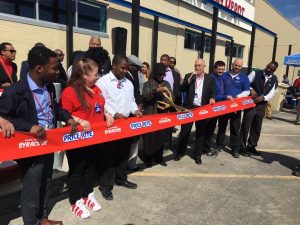
The Price Rite model was seen as a good fit because its parent company (Wakefern) is comprised of a cooperative of Shop Rite store owners that work together to bring lower prices to consumers. They have a robust presence in urban neighborhoods and take pride in supporting the communities in which they are located. This extends to their hiring practices, too. Additionally, the company has never closed a Price Rite Store in the markets that they serve.
Price Rite operates 63 stores in Connecticut, Massachusetts, New Hampshire, New Jersey, New York, Pennsylvania, Rhode Island, Maryland and Virginia. Price Rite stores offer customers an expanded produce department and quality food products at savings up to 50 percent less than traditional supermarkets. The typical Price Rite store is about 35,000 to 40,000 square feet in size and employs anywhere from 75 to 150 associates. The first Price Rite opened in West Springfield, MA in 1995.
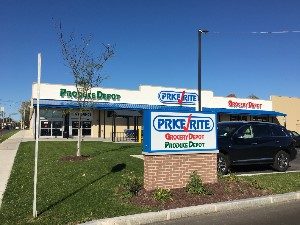
The store opened with great fanfare, pomp and ceremony, all of the local, state and federal political figures were there or sent surrogates. Also present at the Grand Opening was Price Rite executives, President, Neil Duffy, and Executive Vice President, Jim Dorey. Price Rite of South Ave. also made a donation of $3,000 to Sharon Owens, CEO of the Syracuse Model Neighborhood Facility Inc., in the name of the Southwest Community Center. Community supporters that had historically shopped in other places, grabbed shopping carts and went into the new store, many in awe of the bright clean environment created by Price Rite.
At the ribbon cutting ceremony Neil Duffy, president of Price Rite said, “Local residents have been waiting for a supermarket for a long time, and we look forward to becoming a vital part of the community and being a good neighbor while providing local shoppers with the outstanding customer service, variety, value and low prices that Price Rite is known for. Our operation is driven by the philosophy that customers should not have to sacrifice quality to save on price, and we are excited to deliver on that promise.”
Meanwhile, In Another Neighborhood

Seven-tenths of a mile away, Nojaim’s Supermarket, a Gifford Street staple in the near-Westside community had expressed concerns about how a government-funded, new store would affect their “neighborhood store” that had been in operation for 98 years.
Located across the street from the James Geddes Housing project, the grocery store served the near-Westside neighborhood, which over the last decade had become a home to many within the local Hispanic community. Nojaim’s was sensitive to the food preferences of the residents and provided a place where people could find their ethnic favorites within walking distance, filling an otherwise unmet neighborhood need.
The Nojaim’s Renovation

Despite the knowledge that Price Rite’s funding was about to be finalized after years of starts and stalls, Nojaim’s Supermarket decided to proceed with a renovation project that would cost taxpayers $2.4 million in grants and tax exemptions. The project received a $1 million dollar grant from New York State, but even with the grant, Nojaim’s mortgage costs almost doubled.
This wasn’t the first time at the funding trough for Nojaim’s. This was the second time in recent memory that Nojaim’s had received a combo-plate of funding. This seems to occur each time there are funds available for this historically, economically depressed area.
The renovation was delayed for months due to a conflict that involved having parking spaces in the front of the building. City officials wanted the area to be green and vehicle free. Eventually, Nojaim’s prevailed and the project was begun.
One of the advantages Nojaim’s appeared to have had was location. The store’s proximity to a public housing facility across the street was beneficial to commerce. Having a large, captive public housing complex coupled with other residents of a high-density neighborhood was the center of Nojaim’s business model. It was convenient for residents to walk across the street to shop.
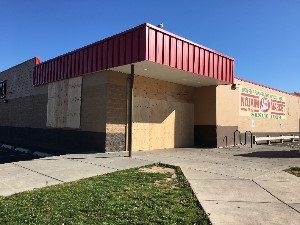
For residents of the Southwest side of Syracuse without access to a vehicle, Nojaim’s was difficult to access. The neighborhood that Nojaim’s served is geographically and demographically different from that of the Southside residents who fought for the Price Rite Supermarket. The West Street Arterial and the heavily traveled West Onondaga Ave. separates these neighborhoods, creating two distinct entities. The sheer number of vehicles traveling in the area, makes it difficult for pedestrians to travel safely in fair weather and nearly impossible when conditions are snowy and strollers are involved.
On the eve of the celebration of the South Avenue Price Rite’s 6-month anniversary, Nojaim’s announced that they were going out of business at the Gifford Street location.
The Government Subsidy Debate
The action caused some to howl their discontent at the world, blaming everyone as the cause of the demise of a decades-old community institution. From Social Media, local television News and both daily and weekly papers, the question was asked, “Why would a government subsidize one business that’s going to result in the demise of another subsidized business?”
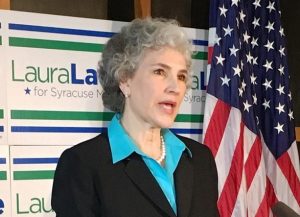
Marilyn Higgins, SU’s former vice president of economic development and community engagement fired off a series of Facebook posts and a poignant letter to the editor criticizing the funding for Price Rite and praised Nojaim’s as a community business leader that was run out of business by government subsidies.
Even Paul Nojaim, keyed in on Price Rite as being the reason for the failure of his store. However, the two entities were only in competition for 6 months. Two other supermarket chains, Aldi’s and Save A Lot had already been engaged in a battle for a portion of the Near Westside’s grocery business providing less expensive merchandise to shoppers. Those competitors had been in operation for far longer than Price Rite’s South Avenue locations.
Republican Mayoral Candidate Laura Lavine stood outside of Nojaim’s, blaming Syracuse Mayor Stephanie Miner and her “liberal policies”. Nothing could be further from the truth. The city of Syracuse’s contribution to the project was about $70,000. Additional support was provided which included in-kind services; this is out of a $2.6 million dollar project budget.
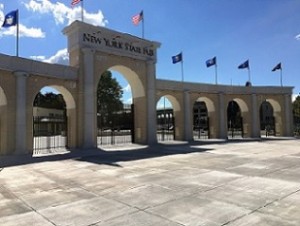
Contrary to popular hyperbole, every crane in the air we see in Syracuse has an incentive dangling in front of it. These incentives are designed to either retain employment or create new jobs.
In Central NY, some areas see more incentives than others. Governor Andrew M. Cuomo announced a $27 million project to transform the 65-acre Orange Lot at the Great New York State Fair which is slated to begin this fall and will conclude before the start of next year’s Fair on August 22, 2018. In addition to fairground direct improvements, $ $49,377,874 was spent by the state for construction of the Lakeview Amphitheater, located near the fairgrounds, on the edge of Onondaga Lake.

Excluding the aforementioned funding, $64 million dollars has been spent and/ or committed to upgrade the 375 acre facility. Constructing new fairground parking facilities, and the Lakeview Amphitheater contributes another $76.3 million dollars. With the stroke of a pen the facility has a total of $140 million dollars committed in funds for upstate economic development.
A New Way Forward
There was a unique set of circumstances in place for the Price Rite funding. Jubilee Homes, a local not-for-profit, owns the building. Therefore, direct transfers of some funds were not made to the parent company Wakefern Food Corp., of Keasbey, N.J. Instead, Jubilee Homes was able to work with VIP Structures, the builder of the Price Rite project, to ensure that funds were spent utilizing local labor sources, many included minority and women-owned companies. This helped to guarantee that the monies benefitted Central NY companies, workers and local families.
Price Rite did receive a good portion of the subsidies directly, though. The application that was made to the Regional Council was in Price Rite’s name. Jubilee Homes leases the building and parking lot facilities to Price Rite’s and acts as the property landlord. Price Rite provides the not-for-profit organization $50,000 annually for the space. The leasing expense increases after a five year period. There is a 10 year lease on the property.
Jubilee Homes only raised about half of the cost as this was a $5+ million dollar project. Price Rite contributed a hefty amount of money to the project, too.
The Loudest Voice

At least one person claims that the development of Price Rite pitted one impoverished community against another. In statements spanning a series of Facebook posts, the former Syracuse University Director of Community Engagement, Marilyn Higgins stated, “Someone should have told Walt Dixie, no.”
Neighborhood members and Jubilee supporters were not pleased and responded swiftly that community members have a right to self-determination regarding the establishments that they choose to support and those that are installed into their neighborhoods.
Area Residents Led by Jubilee Homeowners Speak Up
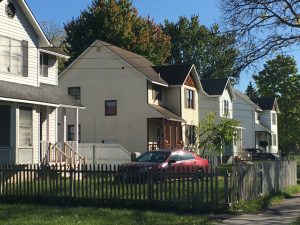
Patricia Allen, a Jubilee Homeowner says, “Walter had gotten me involved in it, with me living in the area, I would like there to be a grocery store close.” For Jubilee area homeowners it’s been a long time coming, for Allen, “I’ve been involved in the process for over 5 years, and that’s a long time.”
When asked why she didn’t shop at Nojaim’s, her reaction was candid, “I never liked Nojaims’ and I’ve been here a long time, and it smelled, and the quality of food, and the prices were too high, I would go all the way to Camillus before I would go over there.”
Ms. Allen continues with her evaluation, “Price Rite has only been open for approximately 6 months and they had to close? It tells me that he’s (Paul Nojaim) a very a poor business man, if that’s the case. Because for as long as he’s been here, there’s no way that he should have closed like that. Myself personally, as close as I am to Nojaim’s, I refuse to go there. The only reason I would go there, would be because my mother would send me there to pick up certain stuff. I have never gone in there to actually buy groceries. No, I couldn’t do it.”
Patricia Allen evoked memories of the old neighborhood she left decades ago, “How ironic, when I first moved to Syracuse, where I’m living now; this is where I was actually living before they tore down all the old houses that were once here. There was a laundromat, a restaurant, a barbershop, and I lived right here. Now, I’m back as a homeowner.”
Another Jubilee Homeowner, Ms. Elmore Davis talked about the perception people may have about the homeowners,” This was never about Nojaim’s, it wasn’t about competition. We’ve been working a long time on this project, we live in a food desert and we needed a grocery store for our neighborhood.”
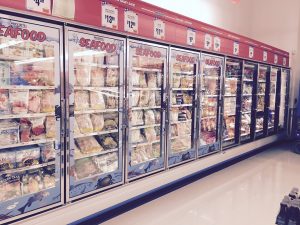
Continuing, she heaps praise on the Price Rite, “the store is nice and clean, and the employees are kind and polite. I live on the corner near the store, and I like the fact that so many people can now walk to a grocery store. If I were buying for a family with kids, I’d be happy because of the low prices. I remember asking Walt, When are we getting a store? When it was announced they wanted to put one back in the community, we all got plastic shopper cards, a symbol of the support we had for a neighborhood grocery store.”
Comments of praise were echoed by those stopped and asked about their shopping experience.

Latoya Cark, who identifies herself as a Westside Resident said, “Price Rite is an ok store, it’s good for the community, as far as lower prices for people to come and pick up their products. Instead of going to these corner stores that’s charging double and triple for a loaf of bread or a gallon of milk. These families are able to come here and they’re able to shop and get what they need.”
And there’s Julio who’s Spanish speaking, happy to see a Price Rite on this side of town,” Erie Boulevard is far for us, this is right here, where we can walk.”
From the atmosphere inside Price Rite it was clear; this store hosts a mosaic of customers, representing the diversity of this Southside neighborhood. Spanish flowed as you passed couples having discussions while examining well-stocked shelves. Several women dressed in traditional Muslim attire with a child are walking north on South Ave., making their way to the neighborhood grocery store.
The Community Investment

NYS Regional Economic Development Council, developed by Governor Cuomo was the largest funding source providing $1,200,000 to the project. Due to the type of development that was being built Jubilee was eligible for $200,000 from the Onondaga County Economic Development Fund and another $200,000 from the Onondaga County Green Improvement Fund, and NYS Assemblyman, Carl Heastie provided another $200,000 towards the $2.6 million dollar project.
As indicated by the chart below, the funding was pieced together. Assembling the funding took Jubilee Homes nearly a decade of garnering support, making proposals, grant writing, and trips to Albany to discuss their neighborhood revitalization efforts with members of the New York State Assembly.
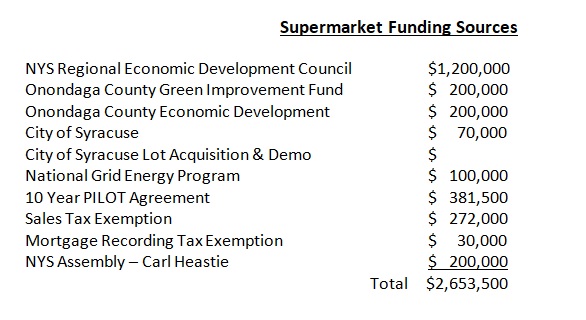 There’s energy surrounding Jubilee Homes, Southwest Community Center-Community Connections and others who are planning the next phase for the South Avenue Business Corridor. Residents are committed to returning this neighborhood to the interdependent, mutually supportive community it once was. Plans call for more small businesses along the corridor and zoning flexibility that will enable small businesses to operate out of residences.
There’s energy surrounding Jubilee Homes, Southwest Community Center-Community Connections and others who are planning the next phase for the South Avenue Business Corridor. Residents are committed to returning this neighborhood to the interdependent, mutually supportive community it once was. Plans call for more small businesses along the corridor and zoning flexibility that will enable small businesses to operate out of residences.
 On October 11, 2017 along with other “Economic Champions”, Jubilee Homes and Walt Dixie were recognized by CenterState CEO, in a statement they said, “For more than 35 years, Jubilee Homes of Syracuse, Inc. has been adding sustainability to the southwest side of Syracuse by providing housing for low income families. This year, CenterState CEO recognized them and honored them with the Community Visionary Award, presented by Wegman’s. This award is given to a person, company or association who embodies the vision of economic opportunity, which have a significant impact on our community.”
On October 11, 2017 along with other “Economic Champions”, Jubilee Homes and Walt Dixie were recognized by CenterState CEO, in a statement they said, “For more than 35 years, Jubilee Homes of Syracuse, Inc. has been adding sustainability to the southwest side of Syracuse by providing housing for low income families. This year, CenterState CEO recognized them and honored them with the Community Visionary Award, presented by Wegman’s. This award is given to a person, company or association who embodies the vision of economic opportunity, which have a significant impact on our community.”
Others are now interested in the story of how this neighborhood rose from the poster child of urban decay to an example as to how to bring a distressed neighborhood back to life. The deal struck by Jubilee Homes could be an example of jump starting other urban businesses designed to fill a void. This is a neighborhood that is in need of more stores, shops and restaurants and the development of the Price Rite store is just the beginning.
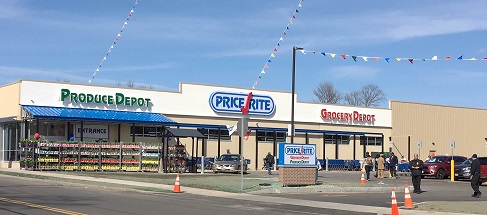 Only 2.6 million dollars were spent, creating 100 jobs for people in the immediate neighborhood. The cost, a mere pittance compared to other economic development branded initiatives. For this neighborhood, $2.6 million dollars will touch more lives than the $140 million being appropriated to the fairgrounds.
Only 2.6 million dollars were spent, creating 100 jobs for people in the immediate neighborhood. The cost, a mere pittance compared to other economic development branded initiatives. For this neighborhood, $2.6 million dollars will touch more lives than the $140 million being appropriated to the fairgrounds.
Thanks to the development of the Price Rite Supermarket, many can now walk to work. There’s African-American management of a store where there’s room to advance and grow a career within the organization. There’s an atmosphere of hope in this once desolate, uninhabited neighborhood. Hope, that won’t be extinguished by those who don’t live or shop anywhere near the Southside.







